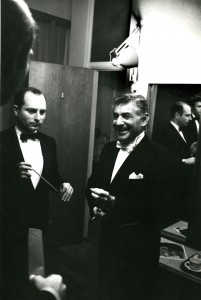by Sedgwick Clark
One would have cough thought it a TB ward in February. But, no, it was Carnegie Hall’s opening cough night in October. Yo-Yo Ma’s pianississimos in Tchaikovsky’s Andante cough cough cantabile took the breath away from the non-coughers at Carnegie Hall’s opening night (10/5). Too bad the coughers couldn’t hold their breaths because they missed some truly ravishing playing by the Mariinsky Orchestra under Valery Gergiev as well.
Traditionally, Russian orchestras have been praised for their excitement but rarely for refinement. My previous concert encounters with the frequently under-rehearsed Mariinsky had left me unprepared for its virtuosic ensemble, perfect sectional balances, and sheer tonal luxuriousness. Not a coarse bar to be heard in this welcome Tchaikovsky festival. Even the cymbal player avoided shattering ears, eliciting striking color and shimmer from his dangerous instrument.
The festival included Tchaikovsky’s six numbered symphonies, Rococo Variations with Ma, and the First Piano Concerto with the latest Tchaikovsky Competition winner, 20-year-old Daniil Trifonov, who emphasized melodic detail over structural rigor, caressing the keys with generous, colorful tone; Gergiev’s accompaniment never overbalanced him. Of the Tchaikovsky symphonies I heard, Nos. 3 and 4 favored luminous sonority and plush attacks over searing intensity.
Scheherazade and Shostakovich’s First Symphony were festival interlopers. The Rimsky used to turn up each season, but it’s played relatively rarely these days. Gergiev was content to revel in the score’s sensuous glories, especially in a seductively broad third-movement, but the finale’s turbulent shipwreck fell short of Witold Rowicki and the Warsaw Philharmonic’s memorable maelstrom at Carnegie in January 1974. The Shostakovich, which in lesser hands can fall apart structurally, turned out to be my favorite of Gergiev’s performances. The second-movement scherzo, especially, was thrillingly precise.
I have to go back to November 1973 at Carnegie for the most unforgettable Tchaikovsky performance I’ve ever heard: a hair-raising Francesca da Rimini during several concerts of Russian music with the Leningrad (now St. Petersburg) Philharmonic under Gennady Rozhdestvensky. (Fairness report: In 2005 Gergiev and Mariinsky played a helluva Francesca in Carnegie too.) Also on that series was the fastest Glinka Ruslan and Lyudmilla Overture one could possibly imagine, with every hemidemisemiquaver astonishingly in place, and Tchaik’s Fifth. In my mind’s eye I can still see the timpanist marking the march tempo of the finale’s coda, showily brandishing his sticks in the air as the music strode to its triumphant conclusion. Whatever happened to such joy and flair in music-making?
The unique character and commitment of the Mravinsky-trained Leningraders was simply overwhelming. No orchestra today matches that style of playing—certainly not the current internationalized version that now exists under the St. Petersburg name—and I doubt we’ll hear its like ever again. Get the electrifying Deutsche Grammophon recordings made in London on tour in 1960 of Rozhdestvensky in Francesca and Mravinsky in the last three Tchaikovsky symphonies. Imagine the intensity level ratcheted up tenfold, and you’ll have an idea of what I heard that evening.
Anecdote time: The fall in 1973 when the Leningrad played, I had a brief stint with the firm handling Carnegie Hall’s p.r., and I was involved in a Times photo shoot of Rozhdestvensky for a feature in Arts & Leisure. One of my colleagues offered the conductor a comb before the photo was taken. He ran the tines over his bald pate, smiled broadly, and said, “It’s for my brains.”
Haitink at the Phil
Bernard Haitink led the New York Philharmonic last week for the first time since 1978. Zachary Woolfe spent three-quarters of his Times review castigating the orchestra for its conservative programming this season, exemplified by Haitink’s selection of Richard Strauss’s Don Quixote and Beethoven’s “Pastorale” Symphony. Zack is correct about the overall programming, but the trend is epidemic throughout the world’s orchestras, even in San Francisco, if they wish to stay in business. He was also correct in judging the performances to be “eloquent” and “enjoyable.” I heard the Tuesday performance (11/15) and particularly warmed to the performances of the orchestra’s Principal Cellist Carter Brey and Principal Violist Cynthia Phelps in the Strauss.
But, to come full circle, I bring up this concert to point out that the audience was uncommonly quiet and respectful, which I expect at Carnegie but not at Lincoln Center. I’ve not been to a Tuesday concert at the Philharmonic in years, choosing to attend on Thursday nights despite the noisier audience. The orchestra players seemed relaxed and enjoying themselves. It showed in their music-making.
Haitink, who was Musical America’s Musician of the Year in 2007, leads more standard repertory for the second of his two programs with the Phil this season: Haydn’s “Miracle” Symphony and Bruckner’s Seventh. Let’s hope he is invited back soon.
Looking Forward
My week’s scheduled concerts:
11/18 Avery Fisher Hall. New York Philharmonic/Bernard Haitink. Haydn: Symphony No. 96 (“Miracle”). Bruckner: Symphony No. 7. (Also 11/19.)
11/19 Carnegie Hall. Baltimore Symphony/Marin Alsop; Caroline Dhavernas, Speaker (Joan of Arc); Ronald Guttman, Speaker (Brother Dominic); other soloists; various choruses. Honegger: Joan of Arc at the Stake.
